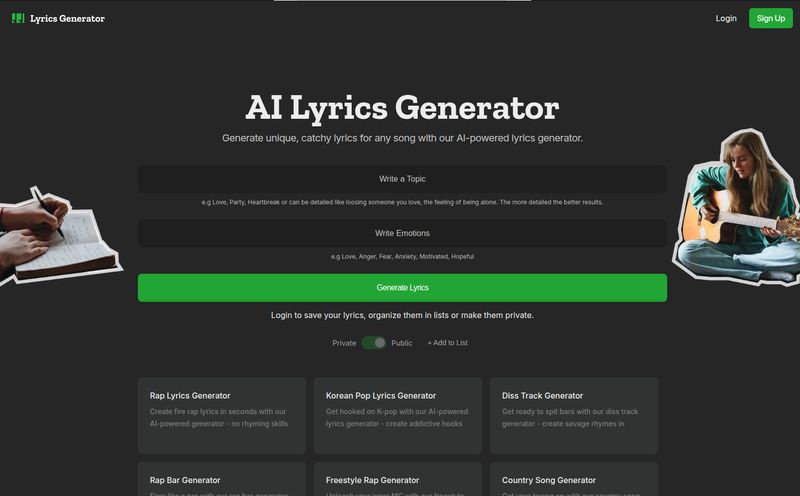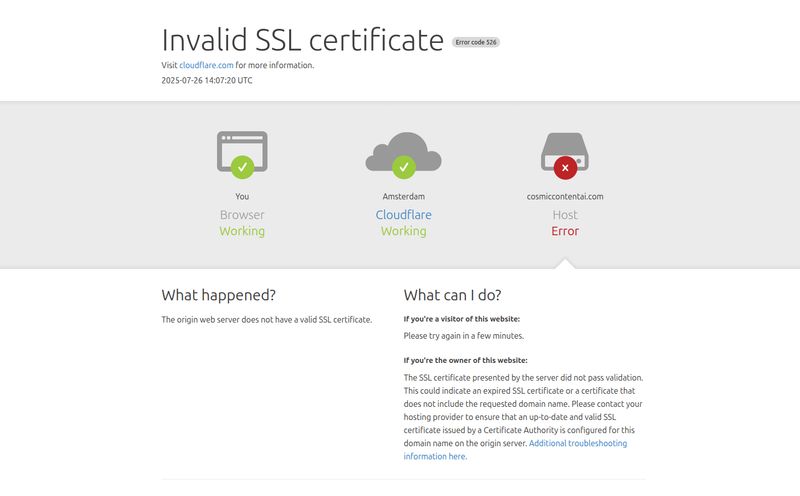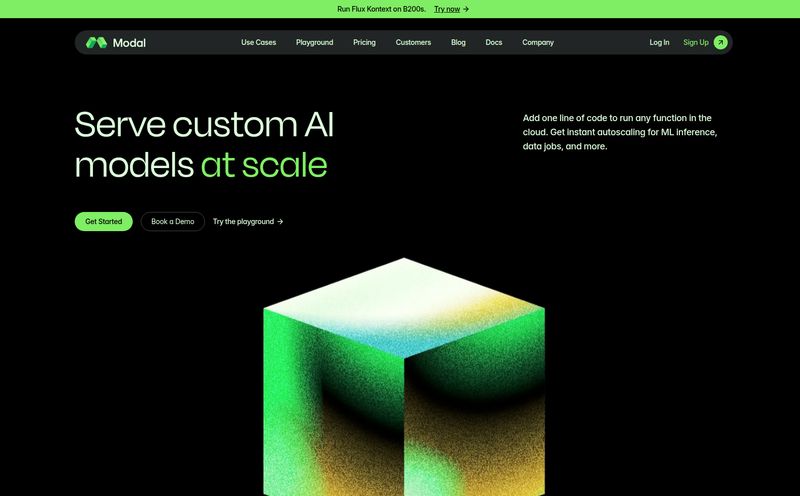I spend a lot of time scrolling through new tech, especially in the creative AI space. It feels like every day there's a new text-to-image generator or a video tool that promises to change everything. But the audio world, particularly AI music production, has always felt a little more... niche. A little more special. That's why I was genuinely intrigued when I first stumbled upon Databass AI.
It wasn't just another plugin. The whole idea was to put sophisticated AI audio tools right into your browser. No hefty downloads, no complicated setups that make your computer sound like it's preparing for takeoff. Just a clean, user-friendly environment for making music. For a guy like me who’s seen countless DAWs (Digital Audio Workstations) with learning curves steeper than Everest, this was a breath of fresh air. It was an exciting concept.
And then, just as quickly as it appeared on my radar, it went quiet. The website now tells a different story. A story of a pause, not a full stop. So, what exactly was Databass AI, and what does its current status tell us about the wild world of AI startups?
The Vision Behind Databass AI
At its heart, Databass AI was built on a simple yet powerful premise: blend cutting-edge AI with audio tools to empower musicians. The goal wasn't to replace the artist but to give them a new kind of paintbrush. Imagine having an assistant that could intelligently separate stems, manipulate sounds in ways that were previously impossible, or suggest melodic ideas—all from a single browser tab. That was the dream.
This approach had some obvious advantages:
- Accessibility: Anyone with an internet connection could theoretically start creating. This lowers the often-expensive barrier to entry for music production.
- Simplicity: By focusing on a user-friendly environment, they were targeting not just seasoned producers but also hobbyists and newcomers who might be intimidated by traditional software.
- Innovation: They were promising advanced audio manipulation features, suggesting a move beyond simple stem separation into more creative and unexplored territories of sound design.
It was a platform that wanted to revolutionize how we think about making music. A noble cause, and one that plenty of people, myself included, were ready to get behind.
A Quick Rise Fueled by Real Buzz
And people did get behind it. This wasn't some little project built in a garage that nobody heard of. Databass AI made some serious waves in a very short amount of time. The message on their site now feels like a final curtain call, but it's also a scoreboard of their achievements.

Visit Databass AI
"Together, we reached over 100,000 users."
Let that sink in. One hundred thousand people. In the world of specialized audio software, that's a massive number. It speaks to a genuine need and excitement for what they were building. This wasn't just hype; it was a product with real users and real traction.
On top of that, they secured backing from the Dorm Room Fund and even earned recognition from Andreessen Horowitz (a16z), one of the biggest names in venture capital. When a firm like a16z even nods in your direction, you know you're onto something. This wasn't just a cool idea anymore; it was a validated business proposition with serious industry backing. They had the users, they had the funding, they had the momentum. It felt like they were on the cusp of becoming a major player in the AI music scene.
So, What's with the 'See You Soon'?
This is the million-dollar question, isn't it? When a startup with so much going for it suddenly puts up a page that says, "This isn't a goodbye, it's a see you soon," it gets you thinking. In my years of watching the tech space, this message can mean a few things.
It could be a 'soft landing' or an 'acqui-hire,' where a larger company buys the tech or, more likely, the talented team behind it. The team gets absorbed, the original product shuts down, and we see their DNA pop up in a bigger company's product line a year later. It could also mean they're in a period of intense restructuring or pivoting. Maybe the initial product wasn't sustainable, or they found a more profitable B2B application for their core technology.
Or, and this is the unfortunate reality for many startups, they could have simply run out of cash. The startup graveyard is littered with brilliant ideas that had funding and users but couldn't bridge the gap to long-term profitability before the money ran out. Building and running advanced AI models is incredibly expensive. It's a race against the clock, and sometimes the clock wins.
Whatever the reason, the message is intentionally optimistic. It leaves the door open. And I, for one, hope they walk back through it someday.
The Promise and Pitfalls of AI Music Creation
The story of Databass AI is a perfect microcosm of the entire AI music landscape right now. The potential is immense, but the path is filled with challenges.
On one hand, you have the incredible potential we've talked about. These tools can be a fantastic creative partner. They can smash through writer's block, handle tedious tasks (who really enjoys manually cleaning up vocal tracks?), and open up sonic possibilities that would take a human engineer weeks to discover. They make powerful tools accessible, and that's always a good thing for art.
But there are downsides. Your creativity is inherently tied to the tool's capabilities. If the AI can't do something, you can't do it either. There's also the question of the 'black box'—sometimes you don't know how the AI is making its decisions, which can be frustrating for producers who want precise control. And of course, the most basic hurdle: no internet, no tool. That's a dealbreaker for any musician working on the go or in a studio with spotty Wi-Fi.
It's a trade-off. Convenience and novel power versus ultimate control and reliability. The perfect tool probably lies somewhere in the middle.
What This All Means for Musicians
So, should we be wary of jumping on the bandwagon of the next cool AI music tool? Not at all. But maybe with a healthy dose of perspective.
The rise and pause of Databass AI is a lesson. It shows that there is a massive appetite for these tools, but it also shows how volatile the space is. My advice? Embrace them. Play with them. Use them as a source of inspiration. But maybe don't build your entire professional workflow around a brand-new startup without a proven track record of longevity. Think of them as exciting new instruments in your orchestra, not the entire concert hall.
The teams building these tools are pioneers, and pioneers sometimes get lost in the wilderness. But they also map the terrain for everyone who comes after. The work done by the Databass AI team has undoubtedly pushed the industry forward, and the lessons learned from their journey will help build the next generation of AI audio tools.
Frequently Asked Questions
- What was Databass AI?
- Databass AI was an AI audio company that offered advanced, browser-based music production tools. It aimed to make creating music more accessible and innovative by blending a user-friendly interface with powerful AI features for audio manipulation.
- Is Databass AI still available to use?
- No. Currently, the website displays a message thanking users for their support and stating, "This isn't a goodbye, it's a see you soon." The platform is not accessible for use at this time.
- Who invested in Databass AI?
- Databass AI secured backing from the Dorm Room Fund and received recognition from the well-known venture capital firm Andreessen Horowitz (a16z), indicating significant industry interest.
- Why did Databass AI shut down?
- The exact reason for the platform's shutdown or pause hasn't been made public. Speculation in the tech industry points to possibilities like an acquisition by a larger company, a strategic pivot, or the common startup challenge of running out of funding despite initial success.
- What are some current alternatives for AI music production?
- While Databass AI is offline, the space is still active. Producers can look into tools like iZotope's suite of AI-powered plugins (like Neutron and Ozone), LANDR for AI mastering, Soundful for AI music generation, or Lalal.ai for high-quality stem separation.
A Final Note on a Promising Tune
It's always a bit sad to see a promising light flicker. Databass AI had all the right ingredients: a great idea, a passionate user base, and the backing of smart money. Their story is a potent reminder of how tough it is to build something new and lasting. But I'm holding onto that 'see you soon.' Whether it's the return of Databass AI in a new form or the talented team popping up elsewhere, I have a feeling the tune isn't over. It's just an intermission.



